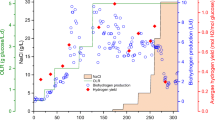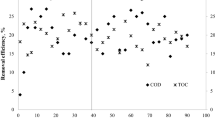Abstract
A laboratory-scale upflow anaerobic sludge bed (UASB) reactor was operated during 273 days at increasing NaCl concentrations (0.5–12.5 g NaCl l−1) to assess whether the stepwise addition of the salt NaCl results in the acclimation of that sludge. The 6.5-l thermophilic (55 °C), sulfidogenic [a chemical oxygen demand (COD) to SO4 2− ratio of 0.5] UASB reactor operated at an organic loading rate of 5 g COD l−1 day−1, a hydraulic retention time of 10 h and was fed with methanol as the sole electron donor. The results show that the adaptation of the thermophilic, sulfidogenic methanol-degrading biomass to a high osmolarity environment is unlikely to occur. Sulfide was the main mineralization product from methanol degradation, regardless of the NaCl concentration added to the influent. However, sulfide production in the reactor steadily decreased after the addition of 7.5 g NaCl l−1, whereas acetate production was stimulated at that influent NaCl concentration. Batch tests performed with sludge harvested from the UASB reactor when operating at different influent salinities confirmed that acetate is the main metabolic product at NaCl concentrations higher than 12.5 g l−1. The apparent order of NaCl toxicity towards the different trophic groups was found to be: sulfate-reducing bacteria > methane-producing archaea > acetogenic bacteria.




Similar content being viewed by others
References
APHA, AWWA, WPCF (1985) Standard methods for the examination of water and wastewater. American Public Health Administration, Washington, D.C.
Brandt KK, Ingvorsen K (1997) Desulfobacter halotolerans sp. nov., a halotolerant acetate-oxidizing sulfate-reducing bacterium isolated from sediments of Great Salt Lake, Utah. System Appl Microbiol 20:336–373
Clarens M, Moletta R (1990) Kinetic studies of acetate fermentation by Methanosarcina sp. MSTA-1. Appl Microbiol Biotechnol 33:239–244
Feijoo G, Soto M, Méndez R, Lema JM (1995) Sodium inhibition in the anaerobic process: antagonism and adaptation phenomena. Enzyme Microb Technol 17:180–188
Gharsallah N, Khannous L, Souissi N, Nasri M (2002) Biological treatment of saline wastewaters from marine-products processing factories by a fixed-bed reactor. J Chem Technol Biotechnol 77:865–870
Guerrero L, Omil F, Méndez R, Lema JM (1997) Treatment of saline wastewaters from fish meal factories in an anaerobic filter under extreme ammonia concentrations. Bioresource Technol 61:69–78
Janssen AJH, Ma SC, Lens P, Lettinga G (1997). Performance of a sulfide-oxidizing expanded-bed reactor supplied with dissolved oxygen. Biotechnol Bioeng 53:32–40
Kempf B, Bremer E (1998) Uptake and synthesis of compatible solutes as microbial stress response to high-osmolality environments. Arch Microbiol 170:319–330
Madigan MT, Martinko JM, Parker J (1997) Brock biology of microorganisms, 8th edn. Prentice Hall, New Jersey
Nozhevnikova AN, Chudina VI (1984) Morphology of the thermophilic acetate bacterium Methanothrix thermoacetophila sp. nov. Microbiology 53:618–624
Omil F, Méndez R, Lema JM (1995) Anaerobic treatment of saline wastewaters under high sulphide and ammonia content. Bioresource Technol 54:269–278
Omil F, Méndez R, Lema JM (1996) Anaerobic treatment of seafood processing waste waters in an industrial anaerobic pilot plant. Water S Afr 22:173–182
Soto M, Méndez R, Lema JM (1993) Sodium inhibition and sulphate reduction in the anaerobic treatment of mussel processing wastewaters. J Chem Technol Biotechnol 58:1–7
Trüper HG, Schlegel HG (1964) Sulphur metabolism in Thiorhocaceae I. Quantitative measurements on growing cells of Chromatium okenii. J Microb Ser 30:225–238
Vallero MVG, Lens PNL, Hulshoff Pol LW, Lettinga G (2002a) Effect of high salinity on the fate of methanol during start-up of thermophilic (55 °C) sulfate-reducing reactors. Water Sci Technol 45:121–126
Weijma J, Stams AJM, Hulshoff Pol LW, Lettinga G (2000) Thermophilic sulfate reduction and methanogenesis with methanol in a high rate anaerobic reactor. Biotechnol Bioeng 67:354–363
Widdel F (1988) Microbiology and ecology of sulfate- and sulfur-reducing bacteria. In: Zehnder AJB (ed) Biology of anaerobic microorganisms. Wiley, New York, pp 469–586
Acknowledgements
This work was accomplished with the support of the Conselho Nacional de Desenvolvimento Científico e Tecnológico (CNPq project 200.798/98-7), an entity of the Brazilian Government responsible for the development of science and technology.
Author information
Authors and Affiliations
Corresponding author
Rights and permissions
About this article
Cite this article
Vallero, M.V.G., Lettinga, G. & Lens, P.N.L. Long-term adaptation of methanol-fed thermophilic (55 °C) sulfate-reducing reactors to NaCl. J IND MICROBIOL BIOTECHNOL 30, 375–382 (2003). https://doi.org/10.1007/s10295-003-0065-x
Received:
Accepted:
Published:
Issue Date:
DOI: https://doi.org/10.1007/s10295-003-0065-x




